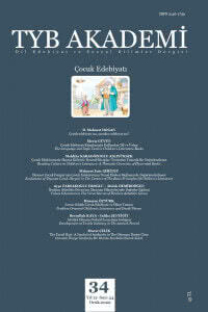Çin'de HIV/AIDS Epidemiyolojisi
HIV/AIDS Epidemiology in China
___
- HAYES, Anna ve QARLUQ, Abdureşit, "'Securitising HIV/AIDS in the Xinjiang Uyghur Autonomous Region'", Australian Journal of International Affairs, 2011/65: 2, ss.203 -- 219
- China Ministry of Health and UNAIDS. A joint assessment of HIV/AIDS Prevention, treatment and care in China. December 1, 2013.
- China's State Council AIDS Working Committee Office and United Nations Theme Group on HIV/AIDS in China, A Joint Assessment, Dec. 1, 2004: 3-4
- China AIDS Response Progress Report. National Health and Family Planning Commission of the People's Republic of China. May 2015.
- Drew Thompson, China Confronts HIV/AIDS, Washington, DC: Population Reference Bureau, 2005.
- First report of AIDS. Center disease control and prevention, June 1, 2001 / Vol. 50 / No. 21. https://www.cdc.gov/mmwr/pdf/wk/mm5021.pdf, Erişim: 10.12.2016
- GILL B, SONG G. "HIV/AIDS in Xinjiang: A Growing Regional Challenge", China and Eurasia Forum Quarterly. 2006; 4:35-50.
- Hui Zheng et.al. "Incidence and risk factors for AIDS-related mortality in HIV patients in China", A Cross-Sectional Study. BMC Public Health 2014/14.
- Jian L, Ye M, Fu-Jie Z, "HIV Antiretroviral Therapy Mode And The Current Situation İn China", China J AIDS STD (In Chinese) 2012, 18(10), ss:711-714
- MAIMAITI, N. et al. "Knowledge, Attitude and Practice Regarding HIV/AIDS among University Students in Xinjiang", Global Journal of Health Science 2010.2(2), ss.51-60.
- Ministry of Health of China; UNAIDS; WHO. Working Report on China's AIDS Epidemic Estimate in 2011; Ministry of Health of China: Beijing, China, 2012
- Na HE and Roger DETELS. The HIV epidemic in China: history, response, and challenge. Cell Research, 15(11-12):825-832, Nov-Dec 2005.
- National Health and Family Planning Commission of the People's Republic of China. 2014 China AIDS Response Progress Report. http://www.unaids.org/sites/default/files/ documents/CHN_narrative_report_2014.pdf, Erişim: 20.12. 2016
- Provinces of China. Last updated 2015. http://www.statoids.com/ucn.html, Erişim: 25.12. 2016.
- RENWICK, Neil, 2002. "The 'Nameless Fever': the HIV/AIDS Pandemic and China's women", Third World Quarterly, 23(2): 377-93.
- TCT. Top 10 Biggest Provinces in China. http://www.topchinatravel.com/china-guide/top- 10-biggest-provinces-in-china.htm, Erişim: 10.12. 2016
- UNAIDS. 2002. HIV/AIDS: China's Titanic Peril. http://www.unaids.org/ whatsnew/ newadds/AIDSChina2001update.pdf (accessed 26 March 2003), Erişim: 15.12. 2016.
- UNAIDS. AIDS in China. Background Information on the Epidemic and the Response. August 2009. http://www.unaids.org.cn, Erişim: 10.12. 2016.
- UNADIS. Fact sheet November 2016, HIV Global Statistic. http://www.unaids.org/en/ resources/fact-sheet, Erişim: 10.2. 2017.
- Walensky RP, Wood R, Weinstein MC, Martinson NA, Losina E, Fofana MO, Goldie SJ, Divi N, Yazdanpanah Y, Wang B, Paltiel AD, Freedberg KA: "Scaling up antiretroviral therapy in South Africa: the impact of speed on survival", J Infect Dis 2008, 197(9):1324-1332.
- WANG Ning, "The challenge of AIDS epidemiology in China", In Proceedings of the National Conference on HIV/AIDS, Beijing, China, 19-21 October 2014.
- WANG Ning, Lu Wang, Zunyou Wu,Wei Guo, Xinhua Sun, Katharine Poundstone, Yu Wang. "Estimating the number of people living with HIV/AIDS in China: 2003-09", Int J Epidemiol, 2010 Dec; 39 (Suppl 2): ss.21-28.
- WHO, HIV/AIDS facts. 2016. http://www.who.int/mediacentre/factsheets/fs360/en/, Erişim: 10.2. 2017.
- World Bank. China population 2013. http://data.worldbank.org/indicator/SP.POP. TOTL?locations=CN, Erişim: 10.10. 2016.
- Xinhua News. "China has 575,000 people with HIV/AID", China daily, http://www. chinadaily.com.cn/china/2015-12/01/content_22595361.htm, Erişim: 10.12. 2016.
- Xinhua News. Sex causes 92.6 pct new HIV cases in Yunnan.China.org.cn. Xinhua, November 30, 2016. http://china.org.cn/china/2016-11/30/content_39815976.htm, Erişim: 10.12. 2016.
- Xinhua News, Xinjiang records over 38,000 people with HIV/AIDS. China.org.cn. November 25, 2015. http://www.china.org.cn/china/201511/25/content_37155412.htm, Erişim: 15.12. 2016.
- ISSN: 2146-1759
- Yayın Aralığı: 3
- Başlangıç: 2011
- Yayıncı: Mustafa Ekici
Kadim Çin Ahlak Felsefesinin Kurucu Çerçevesi -Konfüçyüs-Laozi-Mozi
Çin Halk Cumhuriyeti'nde Dinî Yapı ve Müslüman Milliyetler
Kang Youwei'in Gözünden 1908 İstanbul'u
Çin Tehdidi Retoriğine Karşı bir Barışçıl Benlik Üretimi: Ahenkli Dünya ve Çin Rüyası
Çin Tarzı İslam: Konfüçyanist Müslümanlık (Hui-Ru)
Çin Kurtuluş Ordusu (PLA) ve Çin'in Askeri Gücü Üzerine Bir Değerlendirme
İpek Yolu'nun Yeniden Canlandırılması ve Türkiye - Çin Halk Cumhuriyeti İşbirliğine Etkileri
Kang Youwei'in Gözünden 1908 İstanbul'u
Çin Kurtuluş Ordusu (PLA) ve Çin'in Askeri Gücü Üzerine Bir Değerlendirme
İpek Yolu'nun Yeniden Canlandırılması ve Türkiye - Çin Halk Cumhuriyeti İşbirliğine Etkileri
